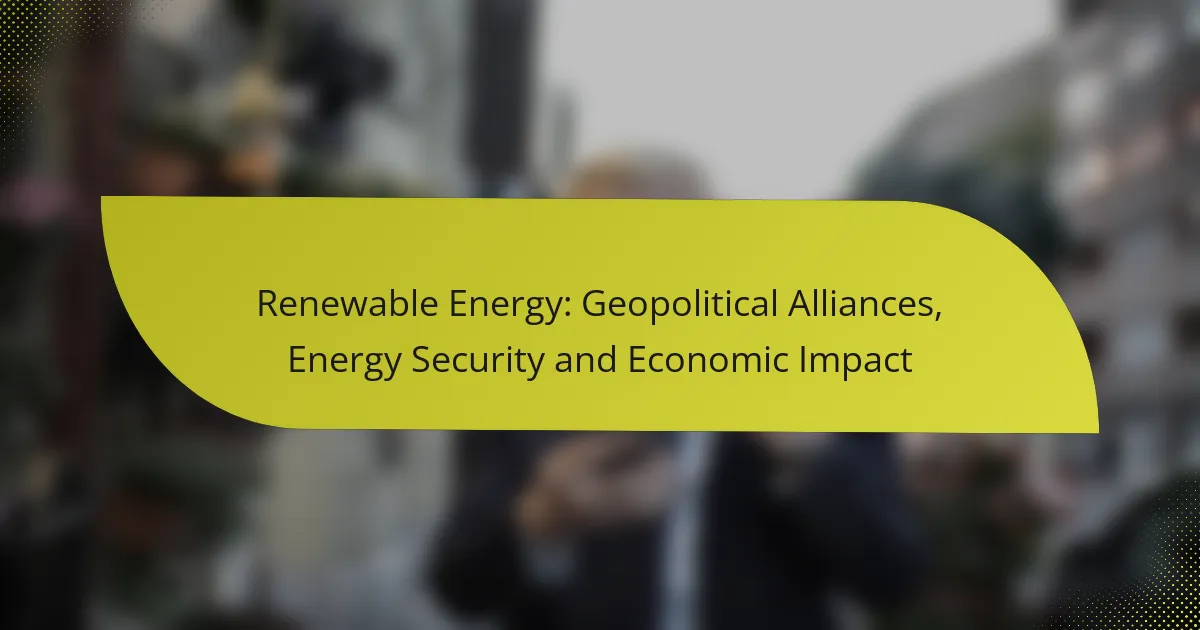Renewable energy is reshaping global dynamics, where geopolitical alliances play a crucial role in determining access to resources and technology. These partnerships not only influence energy security but also have profound economic impacts, driving job creation and investment trends. By transitioning to sustainable energy sources, nations can enhance their energy independence and stabilize their economies amidst geopolitical uncertainties.

How do geopolitical alliances influence renewable energy security?
Geopolitical alliances significantly shape renewable energy security by determining access to resources, technology sharing, and investment flows. These alliances can enhance or hinder a nation’s ability to transition to sustainable energy sources, impacting energy independence and economic stability.
Impact of OPEC on renewable energy policies
The Organization of the Petroleum Exporting Countries (OPEC) plays a crucial role in shaping global energy policies, including those related to renewable energy. While OPEC primarily focuses on oil production, its influence can indirectly affect renewable initiatives by controlling oil prices and market stability.
Countries heavily reliant on oil exports may resist transitioning to renewables, fearing economic repercussions. Conversely, OPEC’s members are increasingly recognizing the need for diversification, leading to investments in renewable technologies to secure their energy futures.
China’s Belt and Road Initiative and energy partnerships
China’s Belt and Road Initiative (BRI) is a significant driver of renewable energy partnerships across Asia, Africa, and Europe. Through this initiative, China invests in infrastructure projects that often include renewable energy components, fostering energy security for participating nations.
These partnerships can lead to technology transfer and capacity building, but they may also create dependencies on Chinese technology and financing. Countries must balance the benefits of these investments with the potential risks of over-reliance on a single partner.
EU’s Green Deal and transatlantic relations
The European Union’s Green Deal aims to make Europe the first climate-neutral continent by 2050, influencing transatlantic relations significantly. This ambitious plan promotes renewable energy sources and sets stringent regulations that impact trade and energy security among member states and their allies.
As the EU pushes for cleaner energy, it encourages collaboration with North American partners, particularly in technology and innovation. However, differing regulatory approaches can create friction, necessitating ongoing dialogue to align strategies for energy security and sustainability.
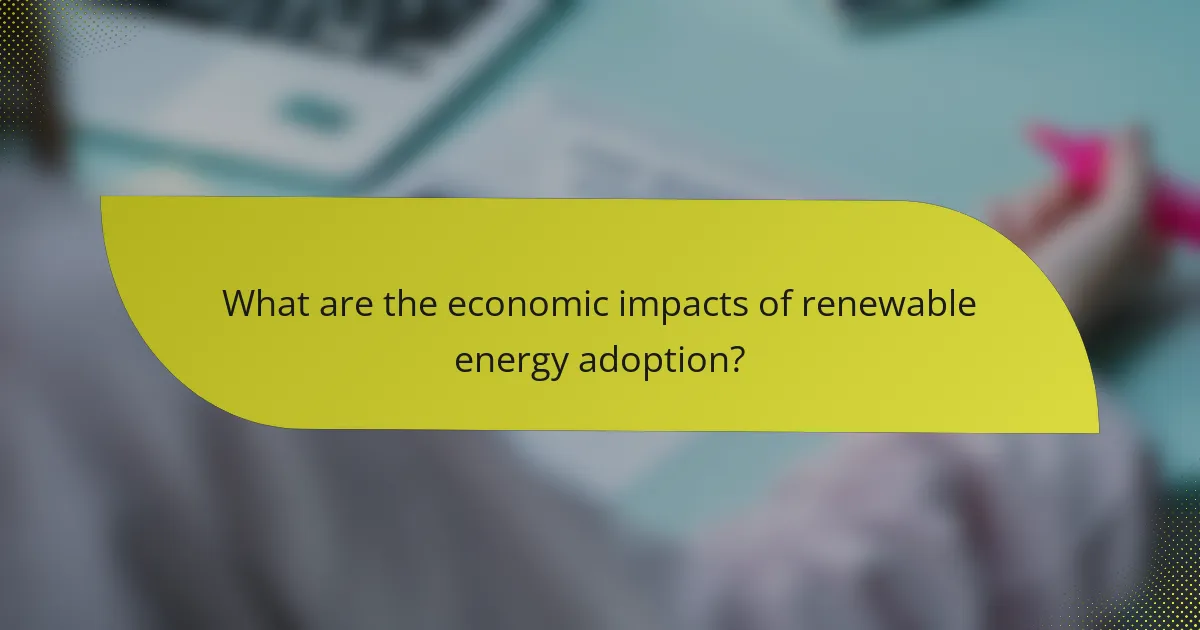
What are the economic impacts of renewable energy adoption?
The economic impacts of renewable energy adoption are significant, influencing job creation, local economies, and investment trends. Transitioning to renewable sources can stimulate growth, enhance energy security, and create a more sustainable economic landscape.
Job creation in the renewable sector
The renewable energy sector is a major driver of job creation, often outpacing traditional energy industries. Jobs in solar, wind, and other renewables can range from manufacturing and installation to maintenance and research, providing opportunities across various skill levels.
In the United States, for instance, the solar industry alone employs hundreds of thousands of workers, with growth rates often exceeding those of fossil fuel jobs. This trend is mirrored in Europe, where investments in renewables have led to substantial employment gains.
Effects on local economies in the US and Europe
Renewable energy projects can significantly boost local economies by increasing investment and creating jobs. For example, wind farms and solar installations often lead to improved infrastructure and increased tax revenues for local governments.
In rural areas of the US, renewable energy projects can revitalize communities by providing stable income sources and attracting new businesses. Similarly, European regions that embrace renewable technologies often see enhanced economic resilience and reduced dependence on imported fossil fuels.
Investment trends in renewable technologies
Investment in renewable technologies has surged in recent years, reflecting a global shift towards sustainable energy solutions. Governments and private investors are increasingly channeling funds into solar, wind, and battery storage technologies, driven by both environmental goals and economic incentives.
In 2022, global investments in renewable energy reached hundreds of billions of dollars, with projections indicating continued growth. This trend is supported by favorable policies, such as tax credits and subsidies, which encourage further development and innovation in the sector.
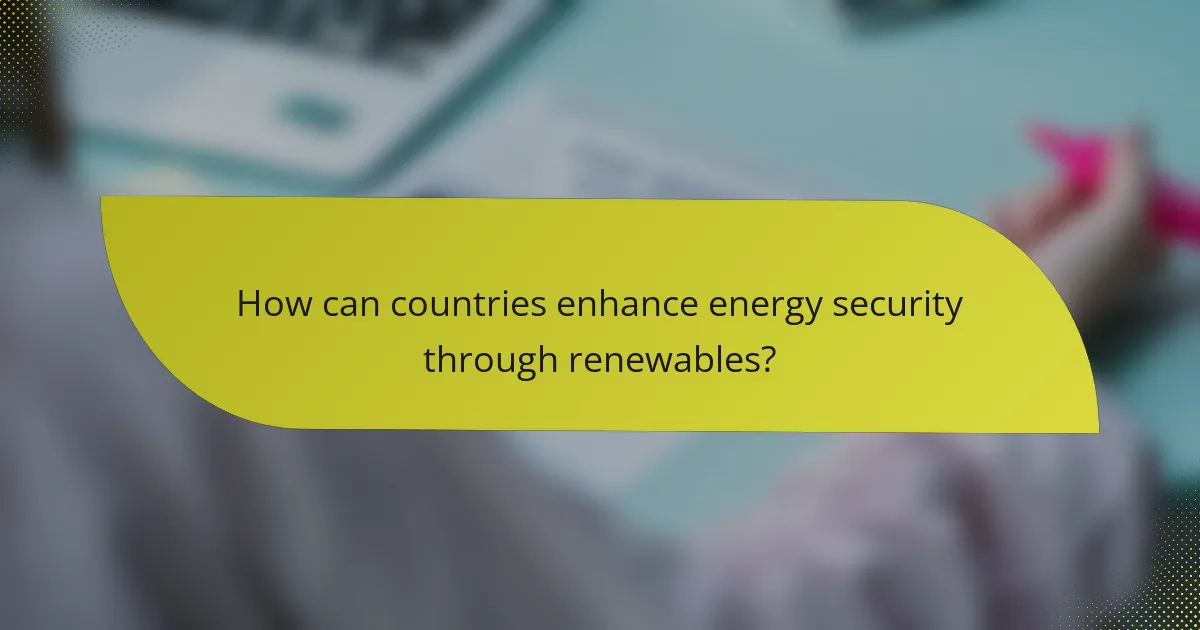
How can countries enhance energy security through renewables?
Countries can enhance energy security by investing in renewable energy sources, which reduces dependence on imported fossil fuels and stabilizes energy supply. By diversifying energy portfolios and integrating renewables into existing systems, nations can better withstand geopolitical tensions and market fluctuations.
Diversification of energy sources
Diversifying energy sources involves incorporating various renewable technologies such as solar, wind, hydro, and biomass. This approach minimizes risks associated with relying on a single energy type and enhances resilience against supply disruptions.
For example, a country that combines solar and wind energy can balance production, as solar output peaks during sunny days while wind energy may be more abundant at night or during storms. This complementary nature helps maintain a steady energy supply.
Strategic reserves and renewable integration
Establishing strategic reserves of renewable energy technologies, such as battery storage or pumped hydro, allows countries to store excess energy generated during peak production times. This stored energy can be utilized during periods of high demand or low generation, ensuring a reliable supply.
Integrating renewables into the existing energy infrastructure requires careful planning and investment in smart grid technologies. These systems can manage energy flow more efficiently, allowing for real-time adjustments based on supply and demand, thus enhancing overall energy security.
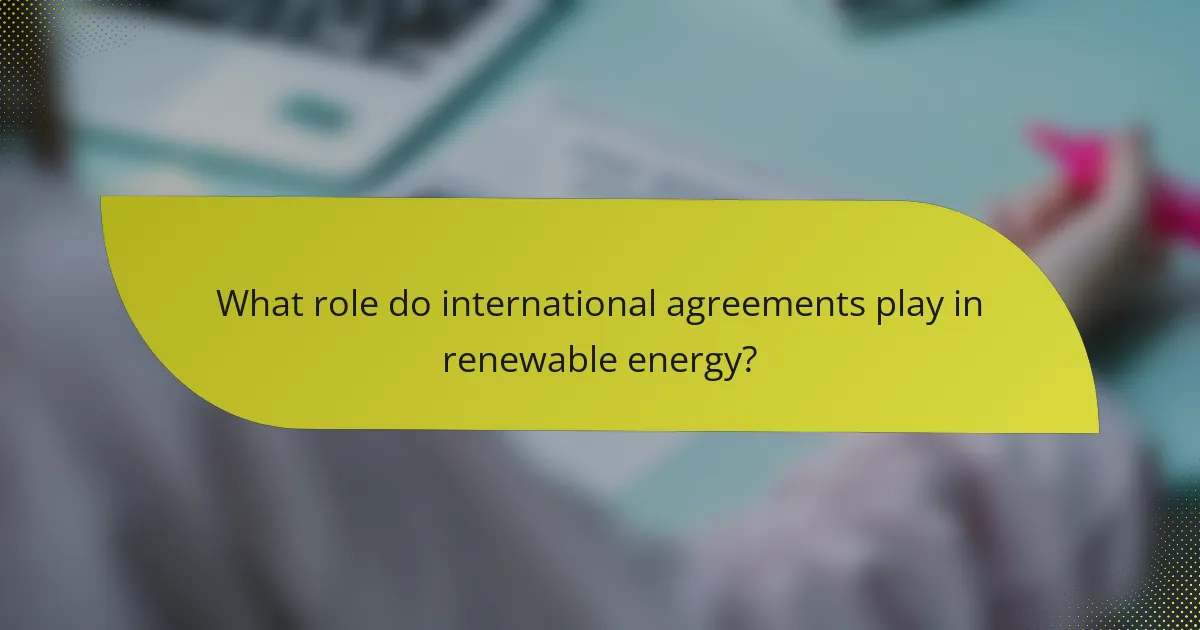
What role do international agreements play in renewable energy?
International agreements are crucial for shaping renewable energy policies and fostering cooperation among nations. They establish frameworks for commitments, funding, and technology sharing, which are essential for achieving global energy transition goals.
Paris Agreement and its implications
The Paris Agreement aims to limit global warming to well below 2 degrees Celsius, with a target of 1.5 degrees. This treaty encourages countries to set nationally determined contributions (NDCs) that reflect their renewable energy ambitions and commitments.
As a result, nations are incentivized to invest in renewable technologies, which can lead to economic growth and energy security. For example, countries like Germany and Denmark have significantly increased their renewable energy shares, benefiting from both environmental and economic advantages.
Impact of COP summits on national policies
Conference of the Parties (COP) summits serve as critical platforms for nations to review progress on climate commitments and adjust their policies accordingly. These gatherings often result in renewed pledges and collaborative initiatives that directly influence national energy strategies.
For instance, following COP summits, many countries have enhanced their renewable energy targets and allocated funding for green projects. This trend illustrates how international dialogue can lead to actionable policies that promote sustainable energy practices globally.
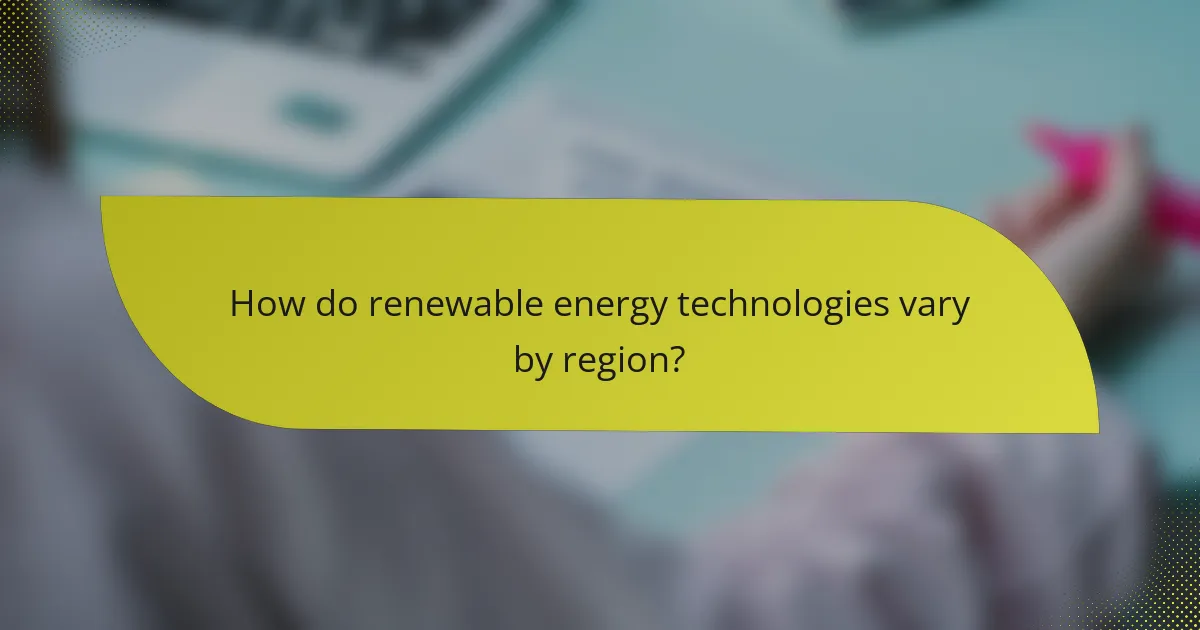
How do renewable energy technologies vary by region?
Renewable energy technologies differ significantly across regions due to factors like climate, resource availability, and regulatory frameworks. These variations influence the adoption rates and types of renewable energy sources utilized in different areas.
Solar energy adoption in California
California is a leader in solar energy adoption, benefiting from its abundant sunshine and supportive policies. The state has implemented various incentives, such as tax credits and rebates, to encourage residential and commercial solar installations.
As of recent years, solar energy accounts for a substantial portion of California’s electricity generation, often exceeding 20% during peak sunlight hours. Homeowners can typically expect a return on investment within 5 to 7 years, depending on system size and local electricity rates.
Wind energy developments in Denmark
Denmark has emerged as a pioneer in wind energy, with a significant percentage of its electricity generated from wind turbines. The country has invested heavily in both onshore and offshore wind farms, making wind energy a cornerstone of its energy strategy.
Currently, wind power contributes to around 40% of Denmark’s total electricity consumption. The Danish government supports this sector through favorable policies and a commitment to reducing carbon emissions, aiming for a fully renewable energy system by 2050.
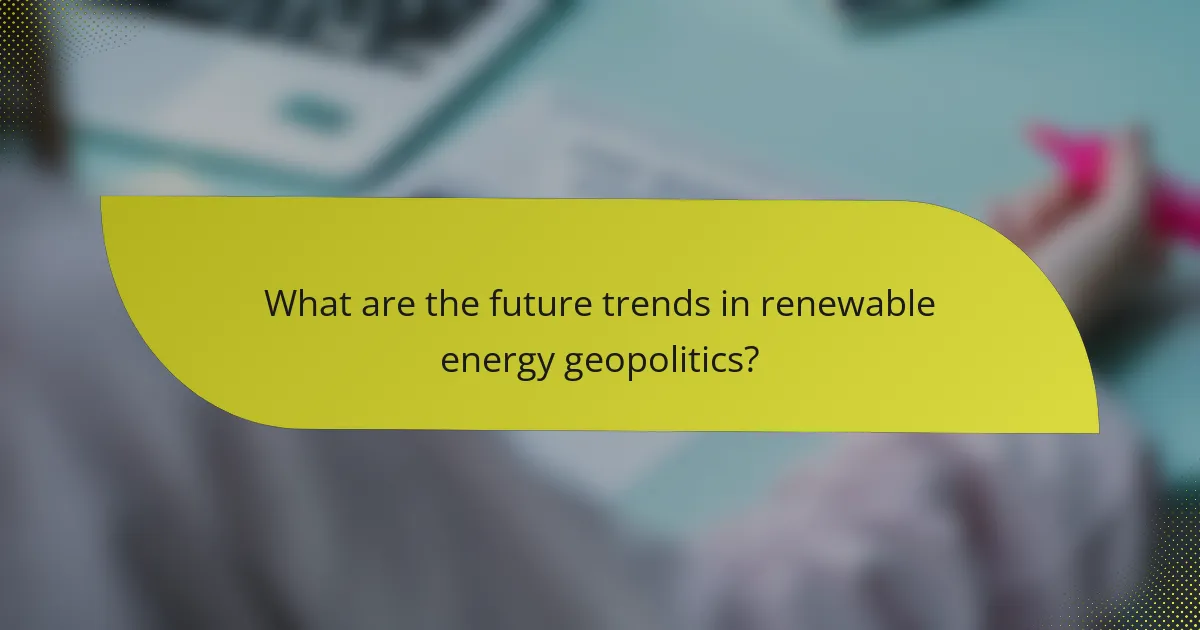
What are the future trends in renewable energy geopolitics?
Future trends in renewable energy geopolitics will be shaped by technological advancements, shifting alliances, and the quest for energy security. Nations are increasingly recognizing the strategic importance of renewable resources, which will influence global power dynamics and economic relationships.
Emerging technologies and geopolitical shifts
Emerging technologies in renewable energy, such as advanced solar panels, wind turbines, and energy storage systems, are driving significant geopolitical shifts. Countries that invest heavily in these technologies can gain a competitive edge, leading to new alliances and trade partnerships focused on energy innovation.
For instance, nations rich in rare earth minerals, essential for manufacturing renewable energy technologies, may become more influential. This shift can alter traditional energy dependencies, as countries seek to secure access to these critical resources, thereby reshaping global energy markets.
As countries transition to renewable energy, they must also consider the implications of energy security. This involves diversifying energy sources and suppliers to mitigate risks associated with geopolitical tensions. A strategic approach could include forming regional coalitions to enhance energy resilience and collaboration on technology development.
